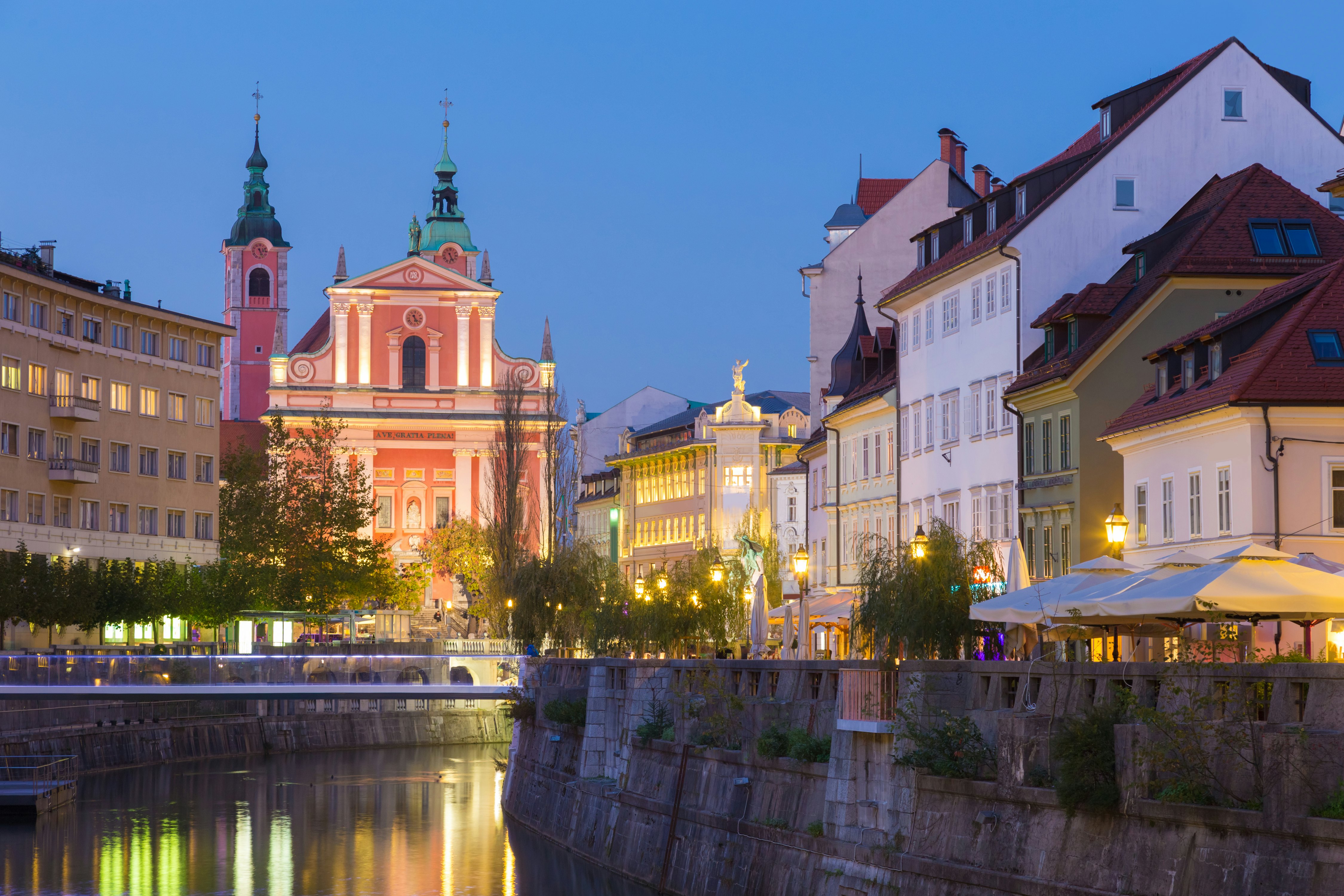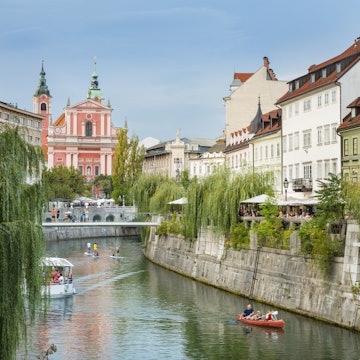
The best ways to travel around in Slovenia



Find your way around in Slovenia with this guide to local transportation © Matej Kastelic / Shutterstock
Slovenia is small and it’s possible to cross the country by car, bus or train within the course of a day.
Of course, Slovenia is best enjoyed slowly, focusing on one region at a time, but it’s nice to know you’ve always got the option to cover ground quickly. Generally, trains are best for bridging longer distances or moving between large cities – like Ljubljana and Maribor. Buses work best within regions. Cars are always an option, though roadways can get crowded and parking is often a problem within cities.
The country places great emphasis on sustainability, and whenever possible, Slovenians generally prefer ditching the car in favor of a long hike or bike ride. Once you see how impressive the walking and cycling infrastructure is (with marked trails fanning out in all directions), you’ll likely feel the same way. Here are our top tips for finding your way around in Slovenia.

Take the bus from Ljubljana to the mountains or coast
The bus system is the most efficient way for moving between the capital, Ljubljana, and the country’s two most-popular destinations: Lake Bled to the north and the Adriatic coastline to the south and west (as well as many other areas). Ljubljana’s main bus station is located just outside the train station. If arriving to the country by train, simply step outside of the station, buy a bus ticket from a nearby ticket kiosk, or online in advance, and board the bus.
An array of carriers offers prices that are budget friendly. A basic weekday ticket from Ljubljana to Bled, for instance, costs approximately €6, and the ride takes about 1¼ hours. A ticket to Koper, on the Adriatic, runs around €10, and the journey takes 2 hours.
Once you arrive at your destination, local buses are available for visitors. In Ljubljana, the local bus network is extensive, though the capital is easily walkable. Unless you’re staying outside the center, you may not need the bus. Ljubljana city buses don’t use tickets, but rather require riders to purchase a contactless Urbana card, available at newsstands and kiosks, which you then top up with cash (€5 or €10, for example) and validate on the bus each time you enter. The Urbana card costs €2, while each bus ride will then deduct €1.30 from the topped-up value. It couldn’t be simpler.
In the popular mountain resorts to the north around Triglav National Park, including Kranjska Gora, Bled, Bohinj, and the Soča Valley, the bus network is especially dense in the summer touring season. With a little forethought, it’s relatively easy to move around without a car (and you’ll save on parking fees). Consult the Arriva online bus timetable to find connections. You can also check out the Zuugle website to find the best hikes and treks you can reach via public transport.

Book train tickets in advance online in Slovenia
Slovenian Railways, the national rail carrier, offers a handy online timetable. Purchase tickets online, at the station, or on the train itself for a slightly higher price. The rail network is modern, well-run and comprehensive, though trains are generally only useful for making specific longer journeys, such as between Ljubljana and Maribor or to access cities in the southeast, such as Nove Mesto, Brežice and Metlika. For most other trips, the bus is often quicker and cheaper. When buying train tickets, be sure to inquire about potential discounts based on age or date of travel, or specific “family” passes that can significantly cut the cost of travel.
Train journeys offer the benefits of being both more sustainable and undeniably more romantic. For true train enthusiasts, the Bohinj Railway in the north runs between two picturesque Alpine valleys, the Bohinj and the Soča River valleys, and features a breathtaking 6327m-long (20,757ft) tunnel and the world’s longest stone arch rail bridge. A special motorail train runs between Bohinjska Bistrica and Most na Soči where you can bring your own car with you.
Many Slovenian trains allow you to bring and stow your bike (for a flat fee of €1.50), but space can be limited. Check the timetable to make sure bikes are permitted, and book early so that you’re not standing at the station disappointed.
Renting a car offers flexibility
Buses and trains are convenient and climate-friendly, but having your own set of wheels can be handier for visiting remote towns and villages as well as wineries for tastings, trailheads, caves and many of the country’s hidden attractions.
Car rental, at agencies located in bigger cities and at Ljubljana’s airport, is affordable. If you’re driving your own vehicle, note it’s compulsory to buy an e-vignette: a weekly, monthly, or annual digital pass to use Slovenia’s roads. A weekly e-vignette costs €16 for cars, €8 for motorcycles. Buy e-vignettes online or at highway service centers near international borders once you enter the country. Rental cars usually come with an e-vignette attached. Fines for driving without the vignette start at €300.
Slovenia’s roads and motorways are well maintained, but the higher elevations can present special challenges. From November to April, some mountain roads and passes may be closed for the season. The Traffic Information Center website maintains updated information on nationwide road hazards, closures and weather delays.
Here are our top driving routes in Slovenia

Bike and hike to stay green in Slovenia
Within regions, distances between towns and cities are often relatively short and manageable on foot or bike. Find detailed regional hiking and cycling maps at tourist information centers, which will often also rent out bikes.
Beyond these more-pedestrian interurban walking trails, you’ll find dozens of higher-profile, long-distance paths that run through beautiful landscapes as they connect remote towns and cities. Trekking trails such as the Juliana Trail around Triglav National Park and the Walk of Peace along the Soča River are structured around self-guided itineraries that bring you from place to place while getting a needed breath of fresh air.
Similarly, long-distance cycling routes, like Bike Slovenia Green (from Kranjska Gora to the sea) and the Slovenia Green Gourmet Route (connecting the country’s eastern and western halves) make it easy to travel Slovenia at human speed.
Traveling Slovenia on a budget? Here are our top tips
Accessible transportation in Slovenia
Part of Slovenia's commitment to responsible travel includes making sure as many visitors as possible can enjoy the country's natural and urban offerings. This inclusivity extends to those living with a disability.
The Slovenian Tourist Board has created a plan-your-trip page specifically for accessible tourism. Here, travelers learn how best to maneuver in each region. Around Lake Bled, for instance, the path around the lake is wheelchair ready. The funicular to the Ljubljana Castle, as well as entry into many of the city's sites and museums, have been made accessible for all tourists. Slovenia’s most-visited attraction, Postojna Cave, is also now barrier-free. Additionally, many sites, museums, hotels, spas and restaurants display a special "Disability-Friendly" certificate to show they have introduced modifications to help mobility-impaired visitors.
As part of this effort, train and bus companies have vowed to do their best to assist passengers with disabilities. Passengers requiring special assistance should contact Slovenian Railways or the individual bus operators 48 hours ahead of their planned departure.















